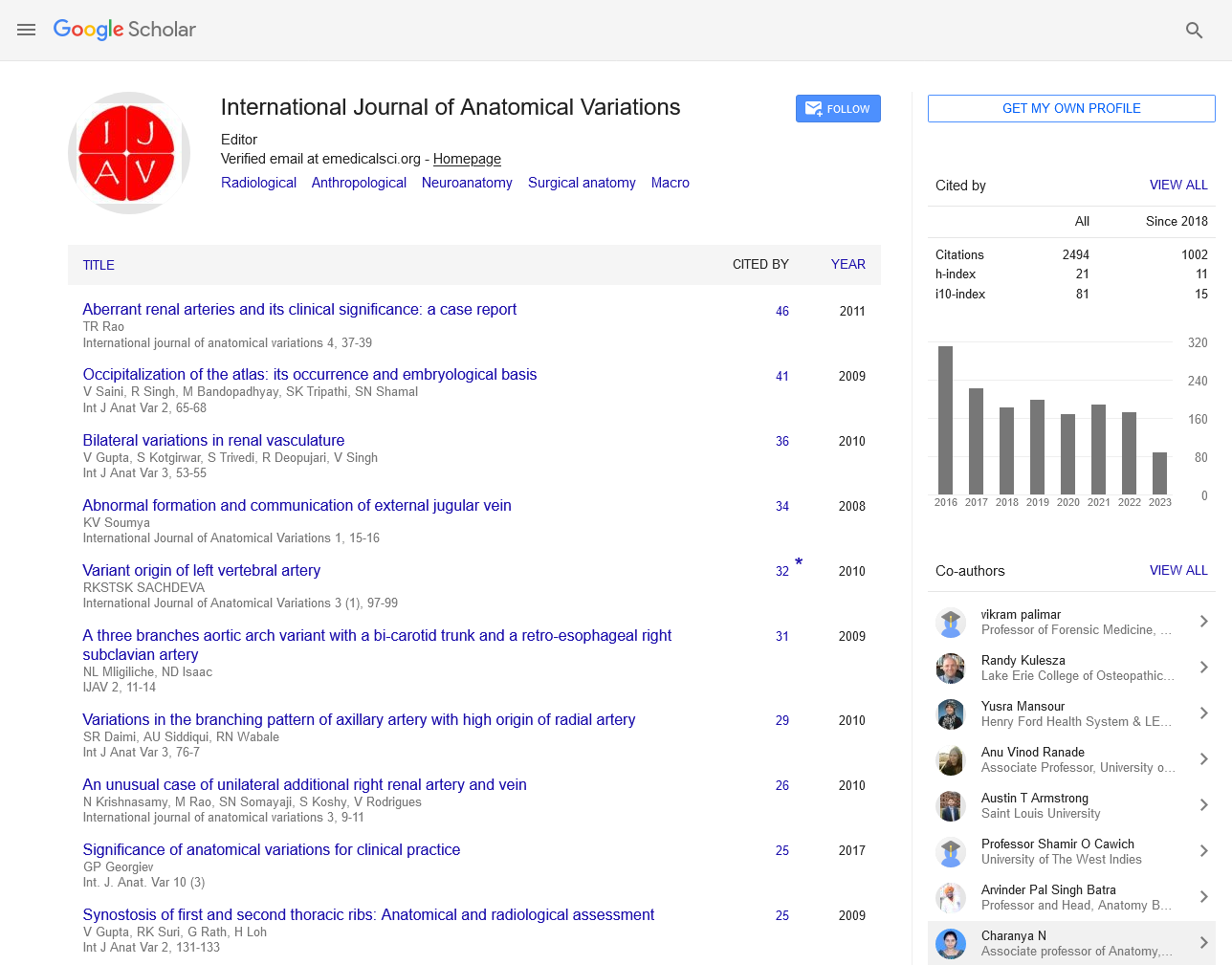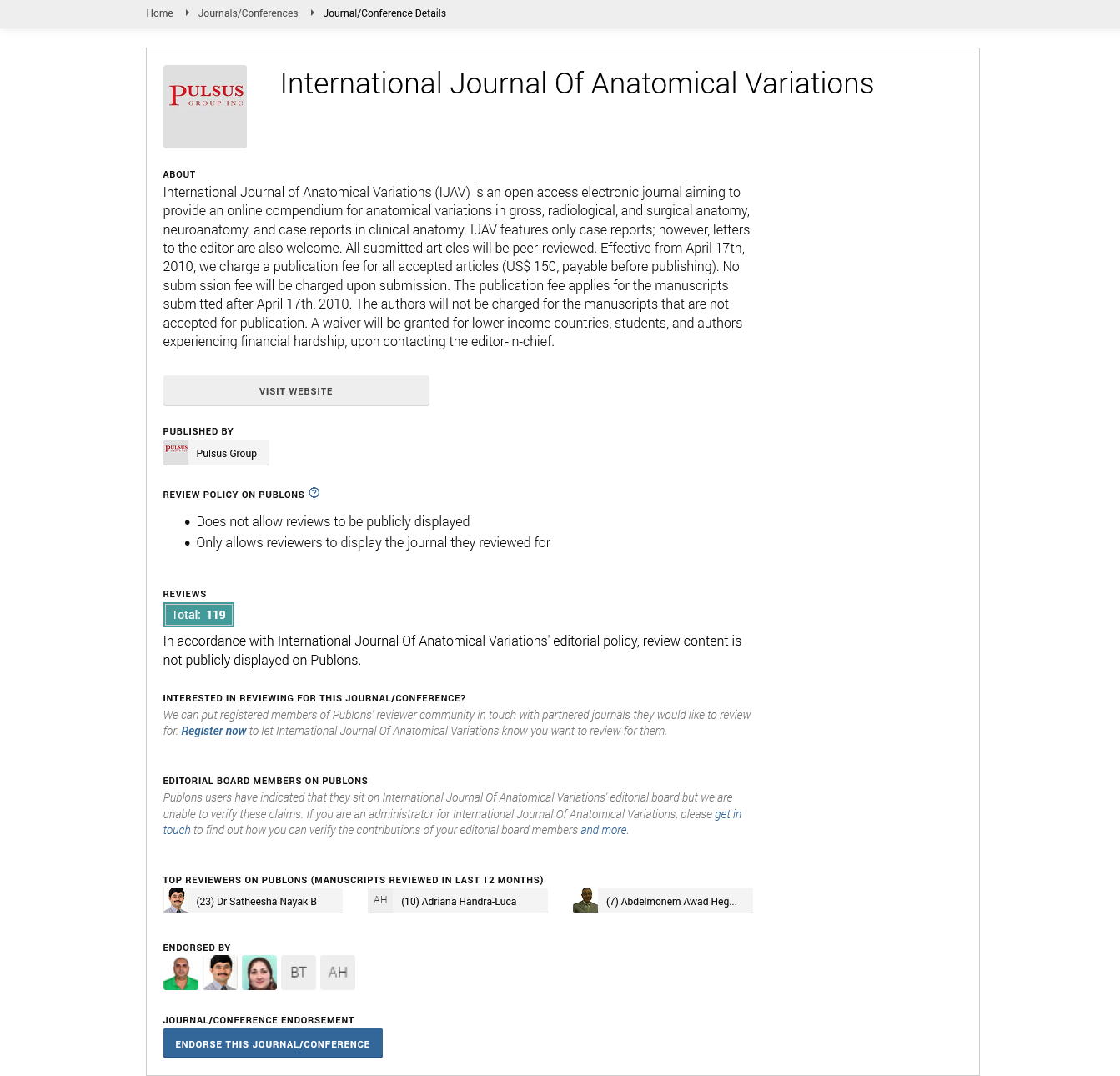Prevalence of Abnormalities in the Median Artery of the Forearm and Its Clinical Relevance
Received: 02-Jan-2025, Manuscript No. ijav-25-7541; Editor assigned: 04-Jan-2025, Pre QC No. ijav-25-7541 (PQ); Reviewed: 18-Jan-2025 QC No. ijav-25-7541; Revised: 24-Jan-2025, Manuscript No. ijav-25-7541 (R); Published: 31-Jan-2025, DOI: 10.37532/1308-4038.18(1).473
Citation: Lathouwer GD. Prevalence of Abnormalities in the Median Artery of the Forearm and Its Clinical Relevance. Int J Anat Var. 2025;18(1): 715-716.
This open-access article is distributed under the terms of the Creative Commons Attribution Non-Commercial License (CC BY-NC) (http://creativecommons.org/licenses/by-nc/4.0/), which permits reuse, distribution and reproduction of the article, provided that the original work is properly cited and the reuse is restricted to noncommercial purposes. For commercial reuse, contact reprints@pulsus.com
INTRODUCTION
The median artery of the forearm is an important but often overlooked vascular structure. In the fetal period, the median artery is a primary vessel that supplies the forearm and hand, but it typically regresses as the radial and ulnar arteries become the dominant sources of blood flow. However, in some individuals, the median artery persists into adulthood, and in rare cases, it may even exhibit abnormal variations. These persistent or abnormal median arteries can have significant clinical implications, particularly in surgical procedures, trauma, and peripheral vascular disease. Understanding the prevalence of abnormalities in the median artery and their clinical relevance is crucial for surgeons, radiologists, and clinicians involved in the management of forearm and hand conditions. This article explores the various abnormalities of the median artery in the forearm, their prevalence, and the clinical challenges they pose [1].
EMBRYOLOGICAL DEVELOPMENT OF THE MEDIAN ARTERY
The median artery is a transient structure that arises during embryogenesis. It originates from the intersegmental vessels of the forelimb bud and supplies the upper limb during early development. In most individuals, the median artery regresses as the radial and ulnar arteries assume the primary role in supplying the forearm and hand. However, in some cases, this regression is incomplete, and the median artery persists, either partially or fully, into adulthood. During the fetal period, the median artery is crucial for the development of the forearm and hand. Its temporary presence allows for adequate perfusion of the developing structures. The complete or partial regression of the median artery after birth is generally considered a normal process. Yet, when this regression does not occur, the persistence of the median artery can lead to variations in the vascular anatomy of the forearm, resulting in what is termed "persistent median artery" (PMA). The persistence of the median artery can occur in several forms: a fully developed median artery that persists throughout life or a rudimentary vessel that remains but does not function as the primary supply of the forearm. This anatomical variation can be incidental or may become clinically significant under certain conditions [2].
TYPES OF ABNORMALITIES IN THE MEDIAN ARTERY
Abnormalities in the median artery of the forearm can be categorized into two primary types: persistence and anatomical variations. Persistent median arteries can be classified based on their continuity and location relative to the radial and ulnar arteries. One common variation is the persistent median artery (PMA), which can be present as a well-formed, fully functional artery or a smaller vessel with limited function. A persistent median artery can arise from the brachial artery or from the ulnar or radial arteries, and it can run alongside the median nerve in the forearm or occasionally within the carpal tunnel. In some individuals, the persistent median artery may be a direct continuation of the brachial artery, while in others, it may arise as a secondary branch. Another abnormality that can occur is the accessory median artery, which is an additional artery that arises from the brachial artery and runs in parallel with the primary median artery. This can lead to a more complex vascular anatomy in the forearm, potentially complicating surgical approaches, such as those involving the carpal tunnel or procedures that require exposure of the forearm arteries. In rarer cases, the median artery may have a variant path, sometimes located near the ulnar side of the forearm or even originating from the radial artery. These atypical origins of the median artery can create confusion in both clinical examinations and radiographic assessments, particularly when performing vascular procedures or interventions in the forearm [3].
PREVALENCE OF MEDIAN ARTERY ABNORMALITIES
The prevalence of abnormalities in the median artery of the forearm varies across populations and depends on the type of anomaly being studied. Persistent median arteries are relatively uncommon, with reports suggesting that they occur in approximately 1-10% of the population. However, the frequency of persistence increases when considering individuals who have undergone imaging studies for unrelated issues, such as CT scans or angiograms, which may incidentally reveal these vascular anomalies. The persistence of the median artery is more commonly observed in the distal forearm and wrist regions, particularly in patients with certain medical conditions or anatomical predispositions. Factors such as age, gender, and ethnic background may influence the frequency of median artery anomalies, but studies suggest that there is no significant correlation between persistence and specific demographic factors. The majority of persistent median arteries are asymptomatic and are discovered incidentally during imaging for other conditions. However, when symptoms do arise, they are often related to vascular compression, aneurysms, or complications during surgery [4].
CLINICAL RELEVANCE AND IMPLICATIONS
The clinical relevance of abnormalities in the median artery of the forearm lies primarily in the potential for vascular complications, especially during surgical procedures. Persistent median arteries can be prone to compression or injury in certain conditions. One well-known issue is the potential involvement of the persistent median artery in carpal tunnel syndrome. In these cases, the artery may be located within the carpal tunnel, and its presence can exacerbate compression of the median nerve, leading to neurological symptoms such as numbness, tingling, and weakness in the hand. Additionally, persistent median arteries may pose risks during procedures like vascular access or forearm surgery, including procedures for wrist fractures, nerve decompression, or radial artery harvesting for coronary artery bypass grafting. If the persistent median artery is not identified during preoperative imaging, it could be inadvertently damaged, leading to complications such as bleeding or ischemia. Abnormalities in the median artery may also be clinically significant in trauma cases, where injuries to the forearm may damage the persistent artery, resulting in hemorrhage or compromised blood flow to the hand and fingers. Given the proximity of the median artery to important structures such as the median nerve and the flexor tendons, its injury can complicate trauma management and necessitate careful surgical planning. In cases of vascular anomalies, such as the formation of an aneurysm in a persistent median artery, surgical intervention may be necessary to prevent rupture or thrombosis. These aneurysms are rare but may present with symptoms of mass effect, such as swelling, pain, or a palpable mass in the forearm [5].
DIAGNOSTIC CONSIDERATIONS
The diagnosis of abnormalities in the median artery is typically made through imaging studies, such as ultrasound, CT angiography, or magnetic resonance angiography (MRA). These imaging modalities allow for precise visualization of the arterial structure, enabling clinicians to identify the presence of a persistent median artery and assess its relationship to surrounding tissues and nerves. In addition to these advanced imaging techniques, arteriography may be used in cases where detailed vascular mapping is required, particularly in the preoperative assessment of patients undergoing forearm or wrist surgery. During physical examination, abnormal pulsations or findings related to vascular compression may prompt further investigation through these imaging modalities. If a persistent median artery is suspected to be involved in symptoms such as carpal tunnel syndrome, a detailed assessment of both the vascular and neural structures may be necessary to guide treatment.
TREATMENT AND MANAGEMENT
Management of abnormalities in the median artery depends on the symptoms and the potential risks associated with the anomaly. In asymptomatic cases, no intervention may be required, and the patient can be monitored periodically with imaging studies. For symptomatic cases, particularly those with carpal tunnel syndrome or vascular compromise, treatment options may include conservative measures, such as splinting or corticosteroid injections, or surgical intervention. Surgical approaches may involve decompression of the carpal tunnel or resection of the persistent median artery if it is causing significant symptoms or complications. In cases of trauma or aneurysm formation, surgical repair or ligation of the abnormal vessel may be necessary to prevent further complications.
CONCLUSION
Abnormalities in the median artery of the forearm, particularly its persistence, are relatively rare but clinically significant. These vascular variations can complicate surgical procedures, contribute to conditions like carpal tunnel syndrome, and present challenges in trauma cases. Understanding the prevalence and types of abnormalities in the median artery, along with their clinical relevance, is crucial for healthcare professionals involved in the diagnosis and management of forearm and hand conditions. Accurate preoperative imaging, careful surgical planning, and appropriate management strategies are essential for minimizing complications and ensuring optimal outcomes for patients with these vascular anomalies.
REFERENCES
- Shigeru H. Glomerular Neovascularization in Nondiabetic Renal Allograft Is Associated with Calcineurin Inhibitor Toxicity. Nephron. 2020; 144 Suppl 1:37-42.
- Konschake M, Olewnik Ł. Unknown variant of the accessory subscapularis muscle?. Anat Sci Int. 97(1), 138-142.
- Youdas JW. Bilateral presence of a variant subscapularis muscle. Int J Anat Var. 2017; 10(4):79-80.
- Janda P, Pękala J, Malinowski K. The subscapularis muscle‐a meta‐analysis of its variations, prevalence, and anatomy. Clin Anat. 2023; 36(3):527-541.
- Jacob SM. Bilateral presence of axillary arch muscle passing through the posterior cord of the brachial plexus. Int. J. Morphol., 27(4):1047-1050, 2009.
Indexed at, Google Scholar, Crossref
Indexed at, Google Scholar, Crossref
Indexed at, Google Scholar, Crossref






